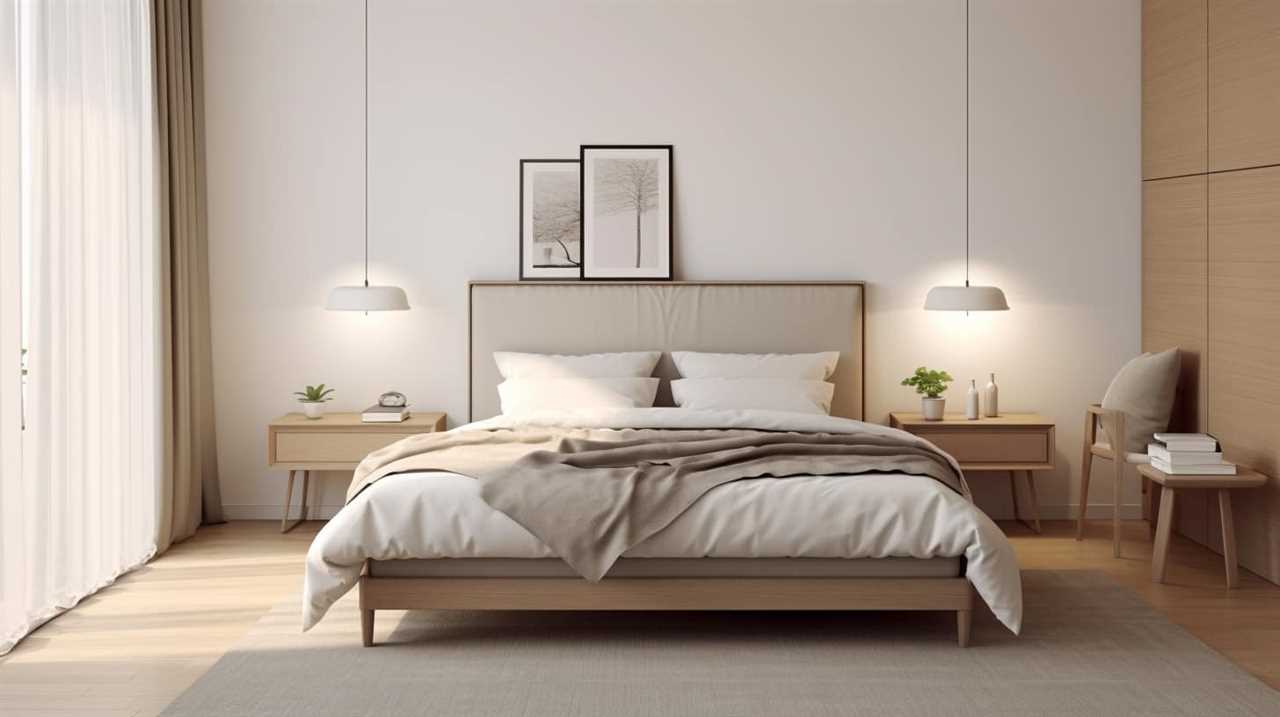Do you feel exhausted from dealing with clutter and financial strain? We have the solution for you!
In this article, we’ll show you how to crack the code and live a minimalist lifestyle on a solid budget.
By evaluating spending patterns, distinguishing wants from needs, and cutting out non-essential expenses, you can achieve financial freedom and peace of mind.
Get ready to simplify your life and focus on what truly matters.

Let’s dive in and start living intentionally!
Key Takeaways
- Assess spending habits and track expenses to identify areas for adjustment and savings.
- Distinguish between wants and needs to prioritize spending based on what truly matters.
- Cut back on non-essential expenditures to free up resources for meaningful experiences and support others in need.
- Maximize the budget by evaluating spending habits, eliminating unnecessary purchases, and finding cheaper alternatives.
Evaluating Spending Patterns
We need to assess our spending habits to determine areas where we can make adjustments and save money. Evaluating our spending habits is crucial in order to gain a clear understanding of where our money is going.
One practical way to do this is by tracking our expenses. By keeping a record of every purchase we make, whether it’s a cup of coffee or a major purchase, we can see exactly how much money we’re spending and on what. This allows us to identify any unnecessary or excessive spending, and make the necessary adjustments to our budget.
Tracking expenses also helps us to prioritize our spending, ensuring that we allocate our money towards the things that truly matter to us. So, let’s grab a notebook or use a budgeting app and start tracking our expenses to evaluate our spending habits and make positive changes.

Delineating Wants Vs Needs
Identifying our true needs versus our wants can be a challenging but essential step in living a minimalist lifestyle on a solid budget. To evaluate our needs accurately, we must assess what is necessary for our basic survival and well-being. This includes things like shelter, food, clothing, and healthcare. On the other hand, wants are the things that bring us pleasure and convenience but are not essential for our survival. It’s important to distinguish between the two to avoid unnecessary spending. Here’s a table to help with the process:
| Needs | Wants |
|---|---|
| Shelter | Fancy home decor |
| Food | Eating out at restaurants |
| Clothing | Designer labels |
| Healthcare | Spa treatments |
Slashing Non-Essential Expenditures
When it comes to managing our budget, it’s important to distinguish between essential and non-essential expenses. By identifying our needs versus our wants, we can make informed decisions on where to make cuts.
Maximizing our budget through these cuts allows us to prioritize our needs over our wants and live a minimalist lifestyle on a solid budget.
Essential Vs Non-Essential
Let’s prioritize our spending by distinguishing between essential and non-essential expenses. Evaluating priorities is crucial when it comes to living a minimalist lifestyle on a solid budget. By identifying what’s truly necessary and what’s not, we can reduce clutter in our lives and make room for what truly matters.

Start by examining your monthly expenditures and categorize them into essential and non-essential. Essential expenses are those that are vital for survival, such as food, shelter, and healthcare. Non-essential expenses, on the other hand, are things that may bring temporary pleasure or convenience but aren’t necessary for our well-being.
Slashing non-essential expenditures can free up valuable resources that can be redirected towards more meaningful experiences and supporting others in need.
Maximizing Budget Through Cuts
We can significantly stretch our budget by cutting back on non-essential expenditures and reallocating those funds towards our financial goals.
One effective way to do this is by evaluating our spending habits and identifying areas where we can reduce expenses. Start by tracking your expenses for a month to get a clear picture of where your money is going. Look for any unnecessary or frivolous purchases that can be eliminated. Consider cutting back on dining out, entertainment subscriptions, or impulse buys.

It’s also important to review your monthly bills and see if there are any services or subscriptions that you no longer need or can find cheaper alternatives for.
Prioritizing Needs Over Wants
To slash non-essential expenditures, we must prioritize our needs over our wants. Evaluating our spending habits is essential in living a minimalist lifestyle on a solid budget. It requires us to take a step back and reflect on our purchases. Are they necessary? Do they align with our values and goals?
By minimizing material possessions, we can save money and reduce clutter in our lives. Start by decluttering your living space and only keeping items that serve a purpose or bring you joy. Resist the urge to buy things on impulse and instead, focus on the essentials.
Prioritize experiences and relationships over material possessions. By making conscious choices, we can ensure that our spending aligns with our true needs and live a more fulfilling, minimalist lifestyle.

Gearing Up Future Savings
One of the key ways we can gear up future savings is by cutting back on unnecessary expenses. Here are four practical steps to help you evaluate saving strategies and plan for long-term financial stability:
-
Track your spending: Keep a record of every expense for a month. This will help you identify areas where you can make cuts and save money.
-
Create a budget: Set clear financial goals and allocate your income accordingly. A budget will help you prioritize your spending and ensure you’re saving for the future.
-
Reduce debt: Pay off high-interest debts first to save money on interest payments. Consider consolidating your debts or negotiating lower interest rates to accelerate your debt repayment plan.

-
Automate savings: Set up automatic transfers from your checking account to a savings account. This way, you’ll consistently save a portion of your income without even thinking about it.
Advocating Mindful Spending
Let’s talk about the importance of mindful spending and how it can positively impact our finances.
By practicing mindful spending, we can make more intentional choices about where our money goes, ultimately helping us save and reach our financial goals.
In this section, we’ll explore practical tips for incorporating mindful spending into our daily lives and discuss the benefits it can bring.

Practical Tips for Mindful Spending
We need to cut back on unnecessary expenses and really think about where our money is going. Here are four practical tips for mindful spending that can help us evaluate our spending habits and implement mindful budgeting techniques:
-
Track your expenses: Keep a record of every penny you spend. This will help you identify areas where you can cut back and make more intentional choices with your money.
-
Set clear financial goals: Determine what you want to achieve financially and set specific goals. This will give you a sense of purpose and help you prioritize your spending accordingly.
-
Practice delayed gratification: Before making a purchase, give yourself a cooling-off period. This will allow you to assess if the item is truly necessary or just a passing desire.

-
Embrace the 30-day rule: If you still want something after 30 days, go ahead and buy it. This rule helps prevent impulse purchases and ensures that you only spend on things you truly value.
Benefits of Mindful Spending
By prioritizing our spending and cutting back on unnecessary expenses, we can maximize our financial resources and live a more intentional and fulfilling life.
Evaluating our spending habits allows us to identify areas where we can make adjustments and develop financial mindfulness. When we’re mindful of how we spend our money, we become more aware of our needs versus our wants. This awareness helps us make better decisions and avoid impulsive purchases that may not align with our long-term goals.
Mindful spending allows us to focus on what truly matters to us, whether it’s saving for a dream vacation or investing in our future. By consciously directing our resources towards our priorities, we can experience a sense of control over our finances and achieve a greater sense of peace and fulfillment.

Now, let’s explore the next step in our journey towards financial stability: strategizing efficient debt reduction.
Strategizing Efficient Debt Reduction
How can we effectively reduce our debt while living a minimalist lifestyle on a solid budget?
Here are four strategies for efficient debt reduction:
-
Prioritize debt payments: Allocate a fixed amount each month to pay off debts with high interest rates first. This way, you can minimize the amount of interest you accumulate over time.

-
Cut unnecessary expenses: Review your budget and identify areas where you can cut back. Eliminate non-essential subscriptions, dining out, or impulse purchases. Redirect these funds towards debt repayment.
-
Negotiate lower interest rates: Contact your creditors and explore options for reducing the interest rates on your loans. This can help lower your monthly payments and accelerate debt repayment.
-
Consider debt consolidation: Consolidating multiple debts into a single loan can simplify your monthly payments and potentially lower your interest rates. However, be sure to carefully evaluate the terms and fees associated with consolidation before proceeding.
By implementing these strategies for efficient budgeting and effective debt management, you can make significant progress towards reducing your debt and achieving financial freedom.

Now, let’s move on to the next section about creating a minimalist budget.
Creating a Minimalist Budget
Let’s talk about creating a minimalist budget.
When it comes to managing our finances, it’s important to prioritize our essential expenses and cut back on unnecessary spending.
Prioritizing Essential Expenses
We can start our minimalist budget by identifying and prioritizing our essential expenses. Evaluating our spending habits and minimizing unnecessary expenses is crucial in achieving a minimalist lifestyle on a solid budget.

Here are four key items to consider when prioritizing our essential expenses:
-
Housing: Focus on finding affordable and sustainable housing options that meet our basic needs without unnecessary frills.
-
Food: Prioritize nutritious and budget-friendly meals by planning and preparing our own food, avoiding excessive dining out or buying expensive convenience foods.
-
Transportation: Opt for cost-effective transportation methods such as public transit, carpooling, or biking whenever possible, reducing the need for a car and its associated expenses.

-
Utilities: Evaluate our utility usage and explore ways to reduce energy consumption, such as using energy-efficient appliances, turning off unused lights and electronics, and insulating our home properly.
Cutting Unnecessary Spending
To cut unnecessary spending and create a minimalist budget, we must carefully analyze our expenses and eliminate any non-essential items or services. Evaluating our spending habits is crucial in identifying areas where we can reduce expenses.
Start by tracking all your purchases for a month and categorize them into essential and non-essential items. This will give you a clear picture of where your money is going.
Once you have identified non-essential expenses, ask yourself if these items or services truly align with your values and goals. Be mindful of reducing impulse buying by giving yourself a cooling-off period before making any non-essential purchases.

It’s also helpful to create a budget and allocate specific amounts for essential expenses, savings, and discretionary spending.
Embracing Minimalistic Mindset
By adopting a mindset centered around simplicity and conscious spending, we can effectively create a minimalist budget that aligns with our financial goals. Here are four practical steps to embrace a minimalist mindset and create a budget that serves our needs:
-
Evaluate spending habits: Take a close look at our expenses and identify areas where we can cut back. Are there any unnecessary subscriptions or impulse purchases that we can eliminate? By being mindful of our spending, we can free up more resources for things that truly matter to us.
-
Set financial goals: Define what we want to achieve financially, whether it’s saving for a down payment on a house or paying off debt. Having clear goals helps us prioritize our spending and make intentional choices that align with our long-term objectives.

-
Adopt minimalist home decor ideas: Simplify our living space by decluttering and focusing on essential items. Minimalist decor not only creates a calm and peaceful environment but also saves money by minimizing the need for excessive furniture or decorative items.
-
Track expenses: Keep a record of our expenses to stay accountable and ensure we’re staying within our budget. Utilize budgeting apps or spreadsheets to monitor our spending and identify areas where we can make adjustments.
Maximizing Financial Discipline
During our journey towards maximizing financial discipline, we’ve found that setting specific financial goals helps us stay on track.
Evaluating our financial goals allows us to determine what we truly value and prioritize our spending accordingly.

By tracking our expenses, we’re able to identify areas where we can cut back and save money. This includes analyzing our monthly bills, discretionary spending, and even small expenses that can add up over time.
Keeping a record of our expenses not only helps us stay accountable but also allows us to make informed decisions about where our money is going.
As we continue to evaluate our financial goals and track our expenses, we can then move on to the next step of streamlining our monthly expenses.
Streamlining Monthly Expenses
As we review our monthly expenses, we can identify areas where we can streamline and save money. Evaluating our spending habits and minimizing our monthly bills is essential for living a minimalist lifestyle on a solid budget. Here are four ways to achieve this:

-
Cut unnecessary subscriptions: Take a close look at your subscriptions and determine which ones you truly need. Cancel the ones that don’t bring value to your life.
-
Reduce energy consumption: Be mindful of your energy usage by turning off lights when not in use, unplugging electronics, and using energy-efficient appliances.
-
Cook at home: Eating out can quickly add up. Plan your meals, make a grocery list, and cook at home. Not only will you save money, but you’ll also have control over the ingredients you use.
-
Negotiate bills and shop around: Don’t be afraid to negotiate your bills, such as internet and insurance. Also, shop around for better deals and compare prices before making a purchase.

Prioritizing Essential Purchases
Fortunately, we can carefully consider our needs and use a coordinated effort to prioritize essential purchases within our budget. Evaluating our spending habits is crucial in determining what’s truly essential and what’s not. By minimizing material possessions, we can free up resources for the things that truly matter to us.
Start by creating a list of your priorities and determine what items are necessary for your daily life. Prioritize spending on basic necessities like food, shelter, and healthcare. Consider investing in high-quality, long-lasting items that will save you money in the long run. Avoid impulse purchases and instead focus on buying items that align with your values and goals.
Building an Emergency Fund
We can start by setting aside a small portion of our income each month to build an emergency fund. Having a safety net is essential for financial stability and peace of mind.
Here are four steps to help you evaluate your savings progress and build a solid emergency fund:

-
Determine your monthly income and expenses: Take a close look at your budget to understand how much you can realistically save each month.
-
Set a savings goal: Decide on an amount you want to save for emergencies, such as three to six months’ worth of living expenses.
-
Automate your savings: Make it easier by setting up an automatic transfer from your checking account to your emergency fund.
-
Track your progress: Regularly evaluate your savings progress and make adjustments as needed to stay on track towards building a strong safety net.

Sustaining a Minimalist Lifestyle
Maintaining a minimalist lifestyle requires consciously evaluating our possessions and regularly decluttering, but it can lead to a sense of freedom and simplicity.
In order to sustain this lifestyle, it’s crucial to evaluate our spending habits. We should ask ourselves if the items we’re purchasing align with our values and truly add value to our lives. By being mindful of our spending, we can avoid accumulating unnecessary possessions and ensure that our purchases are intentional and meaningful.
Additionally, implementing sustainable practices is essential for sustaining a minimalist lifestyle. This can involve reducing waste by opting for reusable products, practicing minimal packaging, and supporting eco-friendly brands.
Frequently Asked Questions
How Can I Overcome the Temptation to Make Impulsive Purchases?
To overcome the temptation of impulsive purchases, we must develop self-control. By being mindful of our spending habits, setting clear goals, and practicing delayed gratification, we can break free from impulsive buying and live a more intentional and minimalist lifestyle.

What Are Some Strategies for Tackling and Reducing Existing Debt?
Debt reduction strategies and budgeting techniques are essential for tackling and reducing existing debt. By creating a realistic budget, cutting unnecessary expenses, and prioritizing debt payments, we can make significant progress towards financial freedom.
How Can I Save Money on Groceries and Other Essential Items?
To save money on groceries and essential items, we prioritize needs over wants and shop smart by using coupons, buying in bulk, and comparing prices. This helps us stick to our budget while still meeting our basic needs.
What Are Some Tips for Maintaining a Minimalist Lifestyle While Still Enjoying Social Activities?
Here are some tips for balancing work and social life while maintaining a minimalist lifestyle: prioritize experiences over material possessions, set boundaries with friends and family, and find low-cost or free activities to enjoy together.
How Can I Stay Motivated and Committed to My Minimalist Budget in the Long Term?
Staying motivated and committed to our minimalist budget in the long term can be challenging. However, by setting clear goals, tracking progress, finding accountability partners, and regularly reassessing our priorities, we can stay on track and achieve financial freedom.

Conclusion
To sum it up, living a minimalist lifestyle on a budget isn’t only attainable, but also rewarding.
By evaluating our spending patterns, distinguishing between wants and needs, and cutting down on non-essential expenses, we can free up funds for future savings and prioritize essential purchases.
By adopting mindful spending habits and streamlining our monthly expenses, we can build an emergency fund and sustain a minimalist lifestyle.
Remember, ‘less is more’ when it comes to finding happiness and financial freedom.

I’m Theodore, and I love tiny houses. In fact, I’m the author of Tiny House 43, a book about tiny houses that are also tree houses. I think they’re magical places where imaginations can run wild and adventures are just waiting to happen.
While tree houses are often associated with childhood, they can be the perfect adult retreat. They offer a cozy space to relax and unwind, surrounded by nature. And since they’re typically built on stilts or raised platforms, they offer stunning views that traditional homes simply can’t match.
If you’re looking for a unique and romantic getaway, a tree house tiny house might just be the perfect option.










